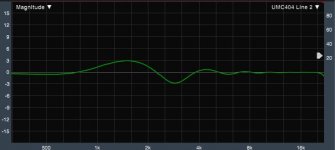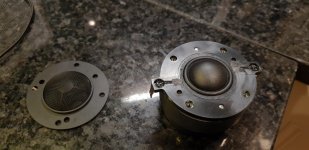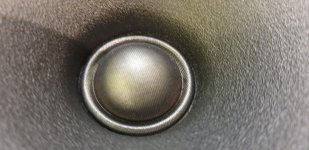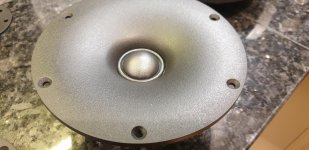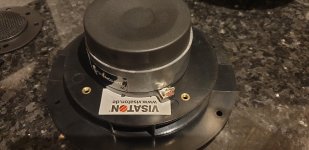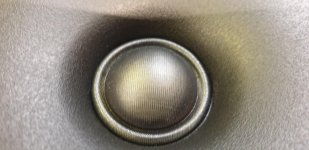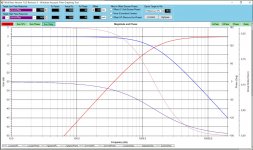I have been using the RS225-8 for years in a 2-way FAST with a full range for a tweeter. Recently, I have been using an RS28F in a Monacor WG300 waveguide with a Purifi PTT6.5 TL speaker with great success. Since I already have FRD and ZMA files handy for these drivers I wondered how well the combo of the RS225-8 and the RS28F in a WG300 would work out together. A very quick simulation in Xsim seemed to yield pretty good results. Although the RS28F is no longer available, I have tested the RST28F in the same waveguide and it measures very close - allowing for similar performance. The crossover is based on the assumption of a certain acoustical delay which I have not been able to measure yet, but estimated based on the positions of the voice coils on a baffle and the depth of the waveguide. The crossover I came up with is strange in that it has a deep notch if invert the polarity of the tweeter and sums up fine if left normal. Not sure why this is.
Schematic for crossover with 1.5kHz crossover frequency:
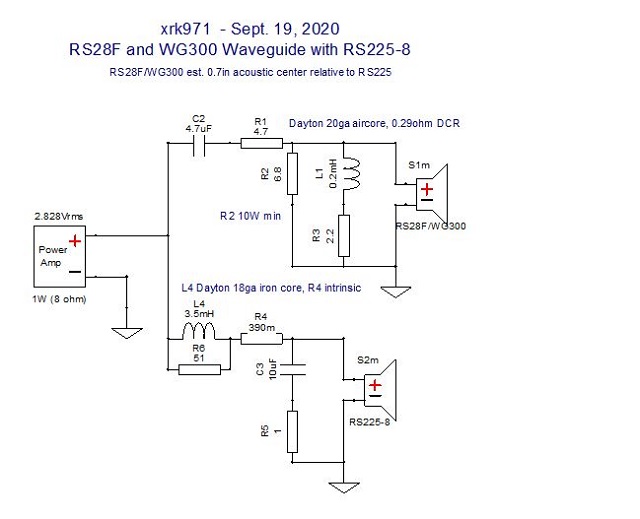
Predicted frequency response (if we mount this in a TL, the bass below 100Hz will extend to 30Hz):
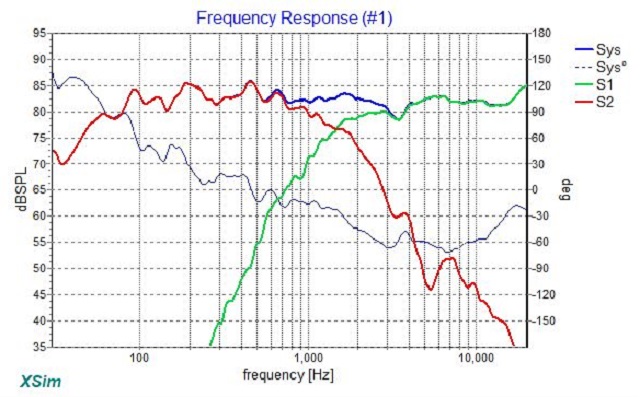
Predicted impedance curve (min ~6ohms):
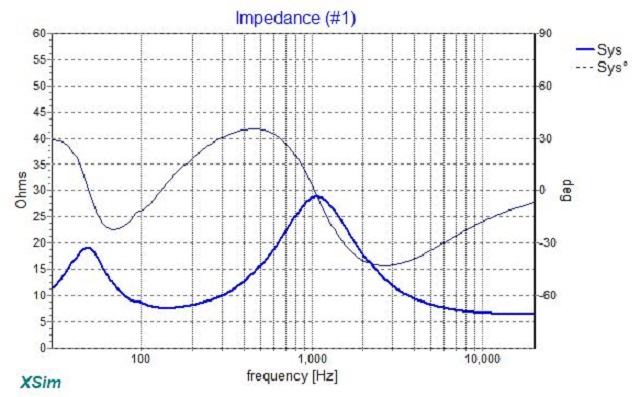
Predicted step response showing great time alignment:
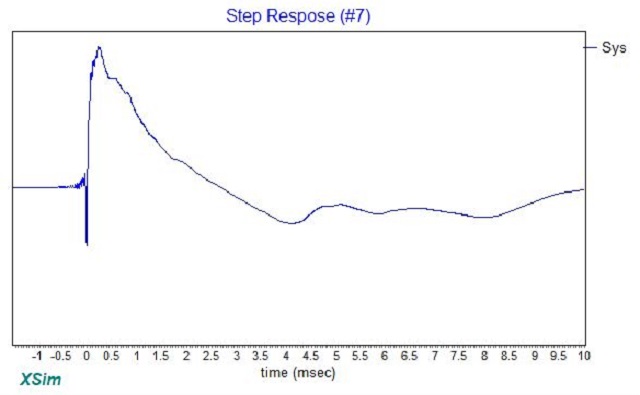
Next step is to make a test baffle and measure in-situ. Is this worth a try and what do you guys think about the polar integration between an 8in driver and 7in waveguide if XO is at 1.5kHz?
One other nice thing about this XO design is that it would fit perfectly into my existing passive XO PCB which has been used for both of the speakers mentioned above, and would look something like this:
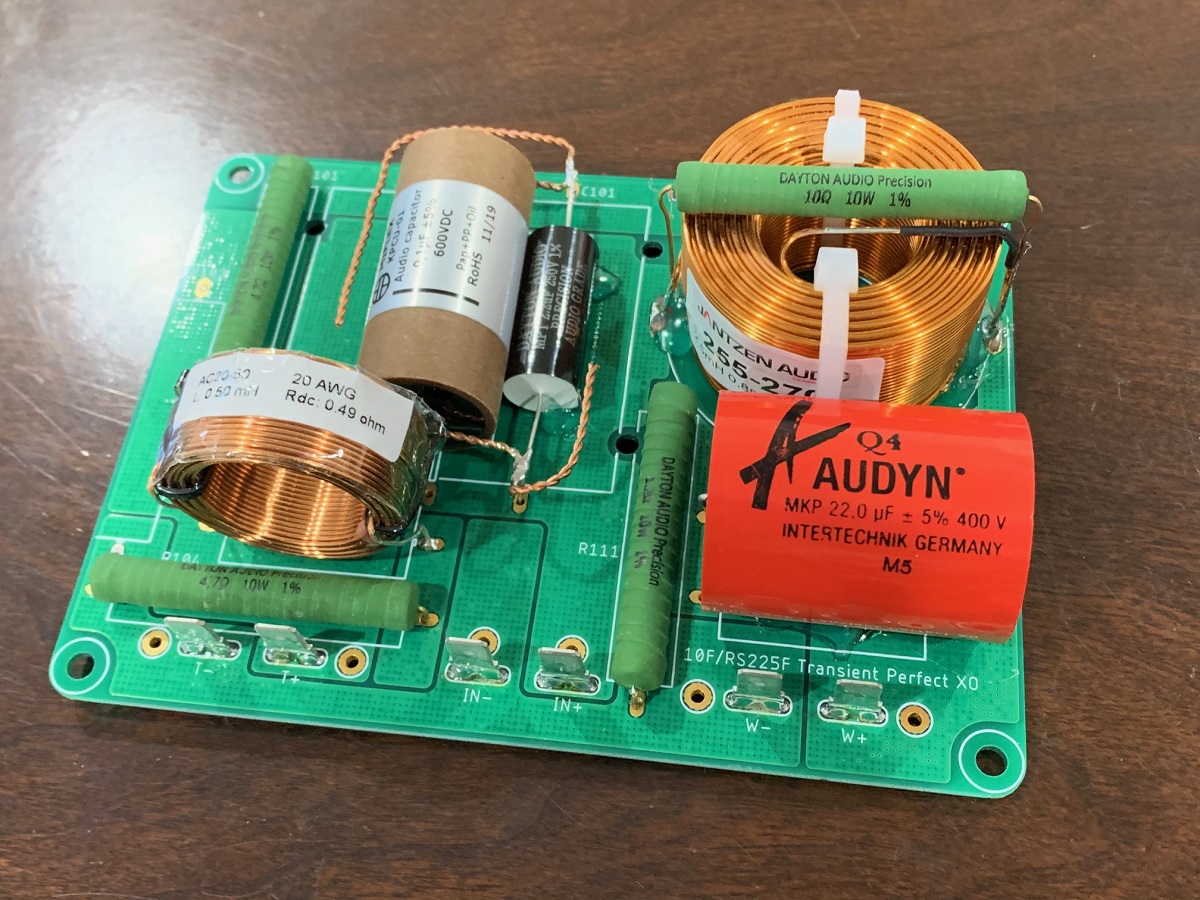
Schematic for crossover with 1.5kHz crossover frequency:
Predicted frequency response (if we mount this in a TL, the bass below 100Hz will extend to 30Hz):
Predicted impedance curve (min ~6ohms):
Predicted step response showing great time alignment:
Next step is to make a test baffle and measure in-situ. Is this worth a try and what do you guys think about the polar integration between an 8in driver and 7in waveguide if XO is at 1.5kHz?
One other nice thing about this XO design is that it would fit perfectly into my existing passive XO PCB which has been used for both of the speakers mentioned above, and would look something like this:
Last edited:
Why do you think that the notch on polarity flip is strange? The better aligned the waves, the deeper the notch(more perfectly out of phase) on reversal of one of the drivers.
An old check on phase in the xo region.
It means you guessed the offset well.
With that and similar areas coupling to the room with 8" & 7" your only concern might be running out of tweeter excursion at higher volume.
Should be fine with the TL version where the RS runs out of xmax a few db earlier, 'cause going lower.
An old check on phase in the xo region.
It means you guessed the offset well.
With that and similar areas coupling to the room with 8" & 7" your only concern might be running out of tweeter excursion at higher volume.
Should be fine with the TL version where the RS runs out of xmax a few db earlier, 'cause going lower.
Last edited:
I guess I have always heard that second order crossovers need inverted tweeters to not have the cancellation notch at the crossover frequency. Perhaps it’s because they are on flat baffle with no waveguide? The waveguide reduces cone excursion on the tweeter so should help it achieve the SPL of the RS225.
"
That statement is true for straight filter theory, not taking into account the time/phase alignment of the two driver acoustical centers.
1) straight crossover electrical filter
2) crossover electrical filter + drivers actual impedance = total system electrical response
3) crossover electrical filter + drivers actual impedance + driver acoustical response + time alignment relationship of drivers = total acoustical response at microphone
A crossover filter shifts 45 degrees per order at the crossover frequency. A crossover filter has separate high pass and a low pass filters.
For a 2nd order hi/low pass crossover, that's 2 x 45 degrees for the tweeter crossover in one phase direction, and 2 x 45 degrees for the woofer in the other phase direction, for a total of 180 degrees between the two outputs.
The difference in travel time from each driver to the measuring microphone need to be addressed.
An estimate is from the front of the drivers voice coil to the microphone, but acoustical measurements are best.
At a temperature of 72F degrees, the speed of sound is 13560 in/sec (1130 ft/sec).
At a crossover frequency of 1.5 kHz, some phase and distance relationships are listed:
1 wave length Phase 360 degrees = 9.04 inches
1/2 wave length Phase 180 degrees = 4.52 inches
1/4 wave length Phase 90 degrees = 2.26 inches
1/8 wave length Phase 45 degrees = 1.13 inches
Or every 1/4" = 10 degrees phase at 1.5 kHz
I guess I have always heard that second order crossovers need inverted tweeters to not have the cancellation notch at the crossover frequency.
That statement is true for straight filter theory, not taking into account the time/phase alignment of the two driver acoustical centers.
1) straight crossover electrical filter
2) crossover electrical filter + drivers actual impedance = total system electrical response
3) crossover electrical filter + drivers actual impedance + driver acoustical response + time alignment relationship of drivers = total acoustical response at microphone
A crossover filter shifts 45 degrees per order at the crossover frequency. A crossover filter has separate high pass and a low pass filters.
For a 2nd order hi/low pass crossover, that's 2 x 45 degrees for the tweeter crossover in one phase direction, and 2 x 45 degrees for the woofer in the other phase direction, for a total of 180 degrees between the two outputs.
The difference in travel time from each driver to the measuring microphone need to be addressed.
An estimate is from the front of the drivers voice coil to the microphone, but acoustical measurements are best.
At a temperature of 72F degrees, the speed of sound is 13560 in/sec (1130 ft/sec).
At a crossover frequency of 1.5 kHz, some phase and distance relationships are listed:
1 wave length Phase 360 degrees = 9.04 inches
1/2 wave length Phase 180 degrees = 4.52 inches
1/4 wave length Phase 90 degrees = 2.26 inches
1/8 wave length Phase 45 degrees = 1.13 inches
Or every 1/4" = 10 degrees phase at 1.5 kHz
Last edited:
I guess I have always heard that second order crossovers need inverted tweeters to not have the cancellation notch at the crossover frequency. Perhaps it’s because they are on flat baffle with no waveguide? The waveguide reduces cone excursion on the tweeter so should help it achieve the SPL of the RS225.
Hi xrk971, nice!
And I think it's strange too.
Yep, a two-way 2nd order should need an inverted high.
After verifying driver polarities with a battery, I always suspect a time-misalignment of 1/2 period at xover frequency..... which produces some ripple, but gets rid of the notch.
Below is the electrical summation from 2nd order, 1500Hz 1/2 period off.
As you can see, entirely possible it might get lost in acoustical measurements.
But 1/2 period is 0.33ms, or about 4.5"...which is alot of distance .....
So I dunno, but something does seem off.....
I give thumbs up to the 8" driver with 7" waveguide at 1.5kHz. Looks like about ka=2.5 for the driver., which i personally like.
Attachments
It’s only theoretical at this point - the simulation was done using measured FRD files for each of the drivers in a 10in wide baffle, but has not actually been built together yet. I do have some older test cabinets made from XPS foam and with a thin plywood veneer. I would have to cut the baffle larger to fit the WG300 waveguide. Or, I have a spare 3/4in BB plywood baffle already cut for an RS225 and a smaller full range. I could get that properly cut for the waveguide rebated and all. Install it in my 24L sealed BB ply cabinet and see how it goes. But the power and clarity of the RS225 is really unleashed when it is mounted in a tapered PMC style TL.
This could sound very good I think as the WG will help you integrate the tweeter with the woofer’s polar response much better.
This could sound very good I think as the WG will help you integrate the tweeter with the woofer’s polar response much better.
I am considering having a go at something like this. I have built the RS225 WAW speaker . I used the PS95. I love them but just recently for no reason other than they are there I put back into my system a build I did with an SB17NBAC35-4 and a DA25BG08-06 tweeter. Had them in place for a week or so.
I think it has made me realise that to my ears, in my room that a tweeter performs better.
I have some RST28F and the waveguides so with a new baffle and XO I can try this design.
When I get the time I shall try this.
Thanks for rhe design X.
I think it has made me realise that to my ears, in my room that a tweeter performs better.
I have some RST28F and the waveguides so with a new baffle and XO I can try this design.
When I get the time I shall try this.
Thanks for rhe design X.
A few photos to share. I saw pictures here mourning the RST28F to the WG along with the tweeters face plate
. Having read a thread on the PE forum I learned that thr grille will come off too. Once you realise it has a plastic surround it makes sense how to remove it. Then it offers up to both WG300 and WG148r very nicely. It would pretty much just mount to the 148 with double sided foam tape alone.
1st 2 photos are the WG300
Last 3 are the 148r
Sorry for the lack of clarity in the pics
. Having read a thread on the PE forum I learned that thr grille will come off too. Once you realise it has a plastic surround it makes sense how to remove it. Then it offers up to both WG300 and WG148r very nicely. It would pretty much just mount to the 148 with double sided foam tape alone.
1st 2 photos are the WG300
Last 3 are the 148r
Sorry for the lack of clarity in the pics
Attachments
Hi Jim,
Neat work! I missed this, so how does it sound simply double sided tape on? One possible issue is that it needs to be a pressure tight seal to keep the rear chamber of the main woofer box from leaking past the waveguide to tweeter interface. Also, don’t you need the faceplate to keep the dome and voice coil from coming out?
Neat work! I missed this, so how does it sound simply double sided tape on? One possible issue is that it needs to be a pressure tight seal to keep the rear chamber of the main woofer box from leaking past the waveguide to tweeter interface. Also, don’t you need the faceplate to keep the dome and voice coil from coming out?
Hi X. No listening or measuring yet I'm afraid. I seem to be going round in circles trying to decide on a what direction to take with my speaker projects! I do feel for me a tweeter will be better for me and my room than a small FR driver. I think the dispersion helps the imaging and soundstage. I may be completely wrong though! Will the WG help the dispersion. ? I get confused whether it is focusing the sound to a point more , or spreading it.
Saw this and had to comment, be it too late. You removed the protection grille of the tweeter. Did you notice the phase correcting shield underneath the grid? That was there for a good reason: flattening the top end response. Removing it results likely in a rough ride above 10kHz. Luckily most of us are quite deaf in that range, but I guessed you better should know...A few photos to share. I saw pictures here mourning the RST28F to the WG along with the tweeters face plate
. Having read a thread on the PE forum I learned that thr grille will come off too.
- Home
- Loudspeakers
- Multi-Way
- Passive XO for Time-Aligned RS225-8 and RS28F in Waveguide
